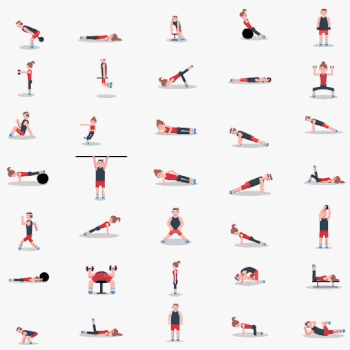A Short Guide To High-Intensity Interval Training (HIIT)

High-intensity interval training, or HIIT, is an excellent option for those looking to lose weight quickly and efficiently.
HIIT is an exercise that alternates between short bursts of high-intensity activity and brief rest periods.
This type of workout is more effective at burning fat than traditional cardio exercises and can be done in a shorter time.
It will improve cardio health and aerobic endurance.
What are examples of high-intensity interval training?
The workout consists of alternating between an intense exercise and a low-intensity exercise.
- Running upstairs versus walking
- Burpees versus jumping jacks
- Plank versus push-ups
- Sprinting versus jogging
- Jogging versus walking
Sometimes you can substitute rest for low-intensity exercise.
How long are the durations of intervals?
There is no definitive answer to this question as it depends on your goals, fitness level, and preferences.
However, a typical ratio for HIIT exercise durations to rest durations is 1:2 or 1:3, meaning that for every minute of HIIT exercise, the individual rests for two or three minutes.
What are common HIIT exercises?
- Treadmill sprints
- Stationary bike sprints
- Rowing machine sprints
- Burpees
- Push-ups
- Squats
- Lunges
- Jumping jacks
- Box jumps
- Kettlebell swings
- Medicine ball slams
- Sledgehammer swings
- Rope jumping
- Mountain climbers
- TRX rows
- TRX squats
- TRX lunges
- Pilates reformer sprints
- Elliptical sprints
- Stair sprints

How can HIIT help you lose weight?
Studies have found that HIIT workouts can help you burn anywhere from five to 20 percent more calories after the workout than steady-state cardio (such as jogging or biking).
Other research has found that HIIT is great for improving cardio-respiratory fitness, but the impact on body fat mass is less pronounced.
The key to successful HIIT training is the intensity level.
HIIT and Macro Counting
While macro counting is a method of losing fat where exercise is unnecessary, interval training is a good option for reducing exercise time.
If you consistently do an HIIT workout (say 3-4 times a week), you should set your activity level to Light on the Macro Calculator.
HIIT workouts for beginners
HIIT workouts can be done using equipment at home or the gym, or with bodyweight exercises.
Choose a high-intensity exercise that’s challenging but still doable. For example, if jogging is your chosen activity, try running upstairs instead of walking.
Do not exceed 80% of your maximum heart rate during your first workout.
6-minute HIIT workout
- Jumping jacks – 1 minute
- Push-ups – 30 seconds, followed by 30 seconds rest.
- Squats – 30 seconds, followed by 30 seconds rest.
- Mountain climbers – 30 seconds, followed by 30 seconds rest.
- High knees – 30 seconds, followed by 30 seconds rest.
- Burpees – 30 seconds, followed by 30 seconds rest.
- Rest – 1 minute
10-minute HIIT workout protocol
- Warm up for one minute at an easy pace.
- Choose your exercise
- Then, increase the intensity for 30 seconds, followed by a 30-second recovery.
- Repeat this cycle eight times for a 10-minute workout.
The benefits of HIIT
- Time ⏰
Instead of 60 minutes of continuous intensity cardio (like brisk walking), a much shorter 15-minute HIIT workout will accomplish the same. - Break a weight loss plateau
If you’ve been doing steady-state cardio and are experiencing a plateau – switch to HIIT. - Cardio-vascular improvement
The research is in agreement with this. - Retaining interest and fighting boredom
Are you walking on a treadmill for an hour? No thanks. But a short, intense cycling workout – is much more enjoyable.
The downsides of HIIT
- Injury risk for beginners
Take it easy if you are starting. - Not for the faint-hearted 🔥
It’s called high-intensity for a reason.
Popular interval training workouts
15-30 Minute HIIT Workouts
There are thousands of HIIT workouts on YouTube.
- Some are geared to men.
- Some are geared to women.
- Some use weights.
- Some use bodyweight.
- Some are adapted for those with injuries or women who are pregnant.
Orange Theory
Orange Theory provides hour-long HIIT sessions with a coach in a class-like setting. It’s great for those who like the motivation a coach can offer and classmates’ support.
Participants can also get a great burn from Orange Theory, burning 500-900 calories per workout depending on your stats and how hard you go at it.
Military Training
You may not be aiming to pass the Army Combat Fitness Test, but military-based workouts such as GrittySoldier offer high-intensity mixes of strength and power, alongside cardio training.
CrossFit
Crossfit is another type of interval training with a lot of variation and a significant strength training component.
Participants work through a Workout of the Day (WOD) consisting of various movements with varying intensity degrees.
WOD Example
- 30 box jumps
- 15 clean and jerks, 65 | 95 lb.
- 30 box jumps
- 15 clean and jerks, 85 | 135 lb.
- 30 box jumps
- 10 clean and jerks, 115 | 185 lb.
- 30 single-leg squats
- 10 clean and jerks, 145 | 225 lb.
- 30 single-leg squats
- 5 clean and jerks, 175 | 275 lb.
- 30 single-leg squats
- 5 clean and jerks, 205 | 315 lb.
Accelerate Your Diet and Fitness Goals with My Macro Solution System
Step-by-step self-guided program -or- fully customized personal macros coaching. Feel exhilarated as you conquer your goals!
MACRO COUNTING
- 130 page step-by-step guide.
- Achieve fat loss without starvation.
- Individually tailored to your body composition.
References
- Sultana, R. N., Sabag, A., Keating, S. E., & Johnson, N. A. (2019). The effect of low-volume high-intensity interval training on body composition and cardiorespiratory fitness: a systematic review and meta-analysis. Sports Medicine, 49(11), 1687-1721.
- O'Keeffe, C. (2015). Systematic review of the efficacy of high intensity interval training versus continuous training for weight loss in overweight and obese individuals.

 A Short Guide To High-Intensity Interval Training (HIIT)
A Short Guide To High-Intensity Interval Training (HIIT) Body Recomposition vs. Cutting: Which is Best?
Body Recomposition vs. Cutting: Which is Best? If You’re a Gay Man, You’re Probably Going About Weight Loss All Wrong
If You’re a Gay Man, You’re Probably Going About Weight Loss All Wrong How Accurate is Your Apple Watch TDEE and Other Fitness Trackers?
How Accurate is Your Apple Watch TDEE and Other Fitness Trackers? Macros for Gaining Muscle and Cutting Fat
Macros for Gaining Muscle and Cutting Fat